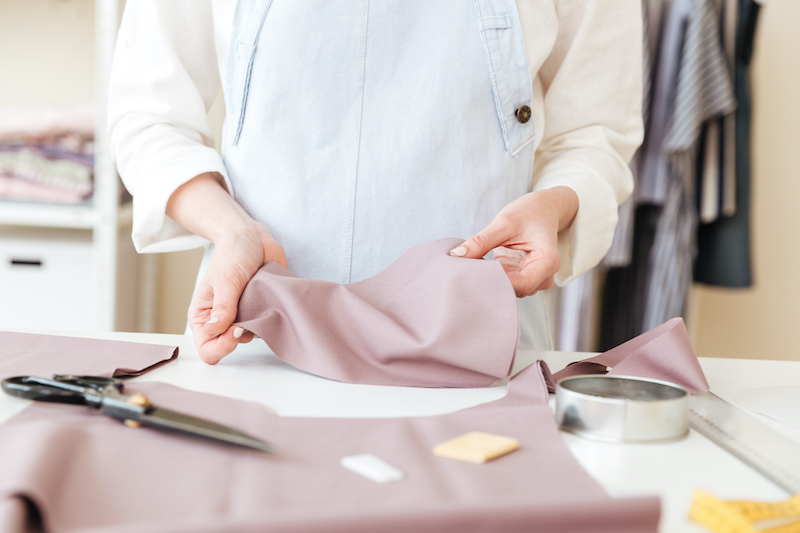Listen on Apple Podcasts | Listen on Spotify
If you’re looking for eco-friendly fabrics for your sustainable fashion brand, then this is the episode for you. I’m going to share the pros and cons of six of my favorite eco-friendly fabrics.
Resources mentioned in this episode:
TRANSCRIPT
If you’re looking for eco-friendly fabrics for your sustainable fashion brand, then this is the episode for you. I’m going to share the pros and cons of six of my favorite eco-friendly fabrics.
First, I will say, it’s important to know that when it comes to fashion there’s no such thing as “perfectly sustainable.” Our goal as sustainable fashion designers is to do the best we can, always striving to improve our supply chain. On that note, I’m going to go through six of my favorite eco-friendly fabrics:
The first one is LYOCELL (TENCEL)
Pros:
-
- A very fast-growing renewable resource from wood pulp (usually eucalyptus trees) that doesn’t require replanting, pesticides, fertilizer, etc.
- The fabric processing involves dissolving wood pulp with a non-toxic solvent. Once the process is completed, the solution is evaporated thereby removing the water, and the remainder is reused in the next cycle.
- Considered a “closed-loop” processing method, which is ideal.
Cons:
-
- Doesn’t always hold dye well.
- Fabric pills (little balls that fray away from the rest of the fiber).
The second one is HEMP
Pros:
-
- Said to be the most durable of all natural fibers.
- Grows plentifully in many different parts of the world.
- Renewable resources, doesn’t require much water to grow, doesn’t require pesticides/insecticides.
- Long roots, so it doesn’t contribute to soil erosion.
- Highly absorbent, lightweight, and yet three times stronger than cotton.
- Very little waste in the production of hemp fabric.
- Less harm to farmers.
Cons:
-
- If it doesn’t have anti-wrinkle chemicals applied the wrinkles tend to wear and the fibers will start to break at the collar and hem.
- Can be labeled organic even if there is a chemical cocktail applied to the fabric in the post-processing.
The third is CUPRO
Pros:
-
- Vegan alternative to silk.
- Created from a part of the cotton plant that is usually discarded.
- Low shrinkage.
- Good moisture absorbency.
- Naturally wrinkle resistant.
Cons:
-
- Takes up stains easily.
- Goes through a salt manufacturing process that requires water.
The fourth one is LINEN
Pros:
- Natural, lightweight, durable, highly absorbent.
- Made from long flax fibers — stronger than cotton.
Cons:
- Wrinkles very easily.
- Bleached to prepare for dyeing.
- Can be GMO.
The fifth one is ORGANIC COTTON
Pros:
- GMO-free.
- Pesticides/insecticides aren’t used in the harvesting process.
- A field must be pesticide-free for at least three years before it can be certified organic.
- Typically a better experience for the cotton farmers (there are thousands of suicides linked to conventional cotton and farmers in India).
Cons:
- Although there are less chemicals used in the process, “certified-organic” doesn’t necessarily mean the cotton is 100% chemical-free. The cotton can be labeled organic but still go through a chemical treatment in the post-processing.
And the last one is MODAL, which is very similar to tencel but modal has a slightly more delicate touch and feel. It feels softer and it is often made into lighter and thinner fabrics compared to Tencel.
Pros:
- Cellulose fiber made from beech trees, 100% biodegradable, 50% more water absorbent than cotton, holds color and is resistant to fading.
- Resistant to shrinking.
- Extremely light and soft.
Cons:
- Prone to stretching and pilling.
- Considered bio-based over natural because of the chemical process to turn it into fabric.
If you’re looking for sustainable fabrics for your own fashion brand, then make sure to download my free email templates that will make you sound like a pro when reaching out to fabric suppliers. The link is in the description of this episode. I’m also going to link to my Fabric Sourcing Kit which provides a list of my top 10 sustainable fabric suppliers that sell sustainable fabrics at low MOQs.



